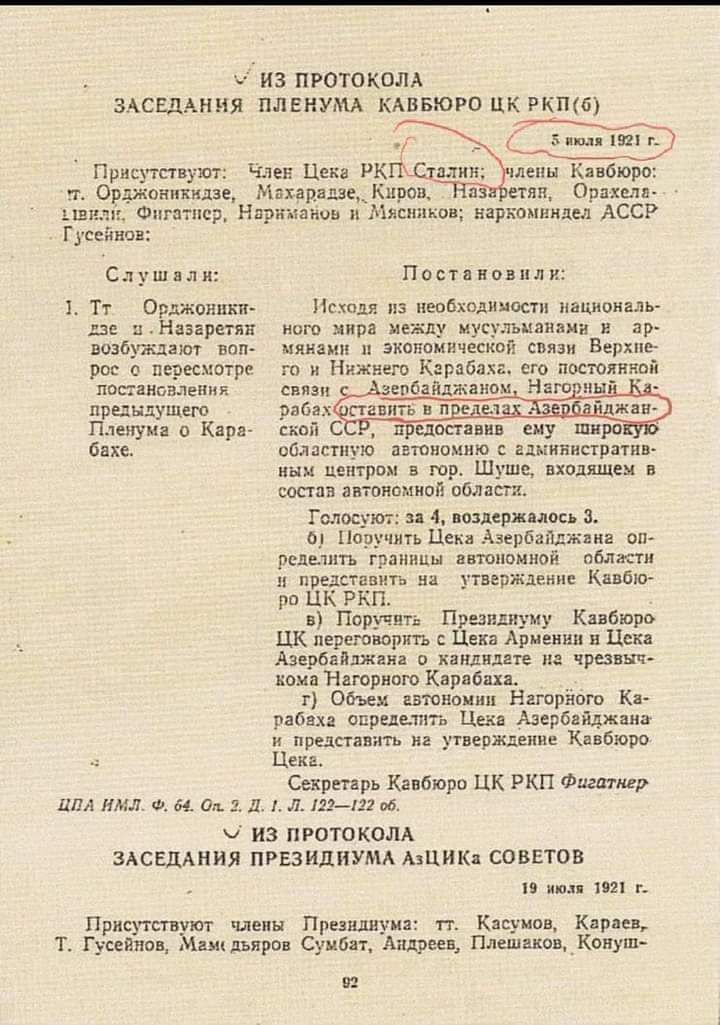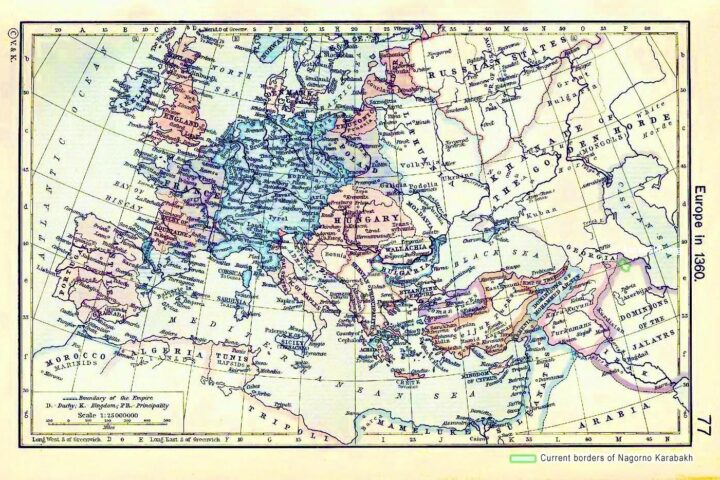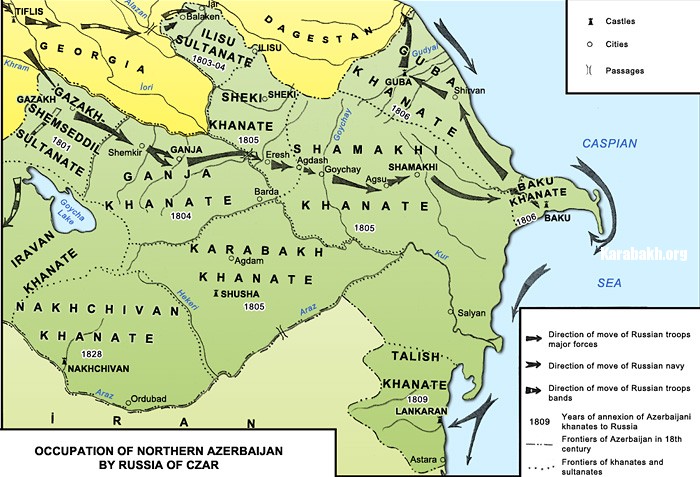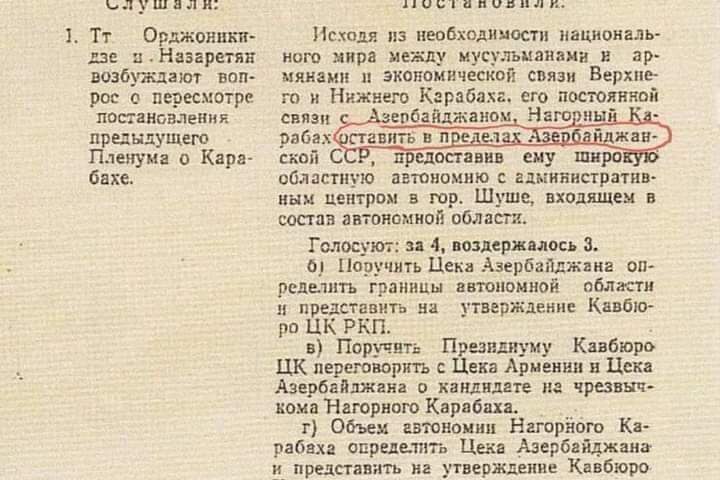ABSTRACT
The author presents the wide panorama of political intrigues around Nagorno-Karabakh which began in the early 1920s when the Bolsheviks occupied the Transcaucasus and slowed down when an autonomous republic was established in the mountainous part of the contested area. The Caucasian Bureau of the C.C. R.C.P. (B.) set up in April 1920 repeatedly returned to the Nagorno-Karabakh issue.
A vast range of hitherto unpublished historical sources and the author’s analysis of the course of events prove that under the Musavat government (1918-1920), the entire territory of Karabakh belonged to Azerbaijan. It was in April 1920, when the Bolsheviks came to power in the Transcaucasus, that it became a target of unjustified Armenian claims.
Soviet Russia was actively involved in what was going on in Nagorno-Karabakh between 1920 and 1923 when the autonomous republic was set up.
Introduction
The political destiny of Karabakh was largely shaped by what happened in the 1920s in the Caucasus.
The policy of Soviet Russia, which occupied the Caucasus, turned Nagorno-Karabakh, Abkhazia, and South Ossetia into seats of potential conflicts. In the first months of the region’s Sovietization, Moscow and its representatives in the Caucasus recognized Nagorno-Karabakh as an inalienable part of Azerbaijan. In the spring of 1921, however, the Bolsheviks decided to find a plausible pretext to transfer it to Armenia. With no plausible pretexts at hand, they armed themselves with the formula “autonomy first, then mobilization of the local Armenians”; in July 1923, the Nagorno-Karabakh Autonomous Region (NKAR) was set up as part of the Azerbaijan S.S.R.
Sovietization of Armenia. The Karabakh Issue is Back on the Agenda
As soon as Soviet power was established in Armenia on 29 November, 1920, the Communists returned the Karabakh issue to the political agenda.
It should be said that the Armenians were prepared to exploit the slogans of proletarian solidarity to realize their narrow selfish interests. On 30 November, 1920, Chairman of the Azerbaijan Revolutionary Committee (Az.R.C.) Nariman Narimanov and People’s Commissar for Foreign Affairs Mirza Huseynov congratulated the Armenian Revolutionary Committee in a telegram. The telegram, however, did not entirely correspond to the decision adopted by the joint meeting of the Politburo and Orgburo of the C.C. of the Communist Party of Azerbaijan.
Nariman Narimanov’s speech at the grand meeting of the Baku Soviet on the occasion of establishing Soviet power in Armenia and the Declaration he read on 1 December, 1920 also contained certain contradictions.
The Declaration said: “Soviet Azerbaijan, which intends to appease the fraternal Armenian working people fighting the Dashnaks who have spilled and are spilling the innocent blood of our best Communist comrades in Armenia and Zangezur, declares that from this time on territorial issues will never cause bloodshed between two peoples who have been neighbors for centuries; the territories of the Zangezur and Nakhchivan uezds are an inalienable part of Soviet Armenia. The toiling peasants of Nagorno-Karabakh are granted the right to complete self-determination; all military actions in Zangezur are being suspended, while the troops of Soviet Azerbaijan are being pulled out.”1
On 4 November, 1920, after discussing the Russian-Armenian treaty, the meeting of the Politburo of the C.C. Az.C.P. (B.) attended by Stalin and Orjonikidze decided that “the suggestion that Nakhchivan and Zangezur should be transferred to Armenia is disadvantageous both politically and strategically.”
On 30 November, 1920, however, the C.C. Az.C.P. (B.) passed a decision on the transfer of Zangezur to Armenia (the Nakhchivan issue was not discussed). Several days later, on 2 December, Envoy Plenipotentiary of the R.S.F.S.R. in Armenia Boris Legran pointed out that Soviet Russia had recognized only the transfer of Zangezur (out of the three territories mentioned above) as legal.2
The Declaration Narimanov read on 1 December mentioned Nakhchivan in addition to Zangezur.
The text which appeared in the Baku newspapers had been falsified by Orjonikidze. On 1 December, he informed Legran and People’s Commissar for Foreign Affairs of the R.S.F.S.R. Georgy Chicherin of the following in a ciphered telegram: “Azerbaijan has already responded and transferred Nakhchivan, Zangezur, and Nagorno-Karabakh to Soviet Armenia.”3 On 2 December, in another telegram, he informed Lenin and Stalin of the following: “Yesterday Azerbaijan announced that Nakhichevan, Zangezur, and Nagorno-Karabakh were transferred to Soviet Armenia.”4 Two days later, the “good news” appeared in Pravda.5
Was Grigory (Sergo) Orjonikidze misinformed, or was it a lie?
When Soviet power was established in Dilijan, G. Orjonikidze discussed the issues mentioned in the Declaration of the government of Azerbaijan with Amayak Nazaretyan by direct telephone line and said in particular that “today, the Soviet gathered for its gala meeting in Baku where Narimanov read the Declaration of the government of Azerbaijan, which pointed out that there were no longer borders between Soviet Armenia and Azerbaijan. From this day on, the territory of the Zangezur and Nakhchivan uezds has became an inalienable part of Soviet Armenia. The Armenians of Nagorno-Karabakh have been granted the right to self-determination. The riches of Azerbaijan—oil and kerosene—have become the riches of both republics.” Overjoyed, A. Nazaretyan exclaimed, “We shall start shouting in the press: Bravo, Azeris!”6
This means that the Declaration of the Chairman of the Azerbaijan Revolutionary Committee of 1 December, 1920 was “slightly” changed by the Bolsheviks. Two Baku newspapers (Kommunist on 2 December, 1920 and Bakinsky rabochy on 3 December, 1920) wrote about the “right to self-determination” granted to the toiling peasants of Nagorno-Karabakh, while on 7 December, 1920 the Armenian Kommunist informed readers that “Nagorno-Karabakh has been recognized as part of the Armenian Socialist Republic.”
The flagrant falsifications enraged Nariman Narimanov. In June 1921, he instructed People’s Commissar for Foreign Affairs Mirza Huseynov, who was in Tiflis, to inform the Caucasian Bureau that “since they refer to my Declaration, I must say that it states the following: Nagorno-Karabakh has been granted the right to free self-determination.”7
Did anyone in Armenia see the real text of the Declaration? We know that the text signed by Narimanov and Huseynov was telegraphed to the Armenian Revolutionary Committee. After reading the document, Askanaz Mravyan (a member of the Armenian Revolutionary Committee) informed Armenian representative in Moscow Saak Ter-Gabrielyan that Azerbaijan had announced that Zangezur and Nakhchivan had been united [with Armenia] and that a referendum would take place in Nagorno-Karabakh.8
The collection of documents Velikaya Oktyabrskaya sotsialisticheskaya revolutsia i pobeda Sovetskoy vlasti v Armenii (The Great October Socialist Revolution and the Victory of Soviet Power in Armenia) published in 1957 in Erevan contained the original text of the Declaration kept in the Central State Archives of Armenia.9
Since the mid-1980s, Armenian authors have been using the “doctored” text; this is true of those who were involved in putting together the documentary collection of 1957.10
Nagorny Karabakh: istoricheskaya spravka (Nagorno-Karabakh: Historical Information) for example, compiled by the Academy of Sciences of the Armenian S.S.R., relied on the “edited” text published by the Kommunist newspaper on 7 December, 1920 rather than on the original text available from the 1957 collection of documents. The Armenians have developed the habit of using falsified historical documents.







